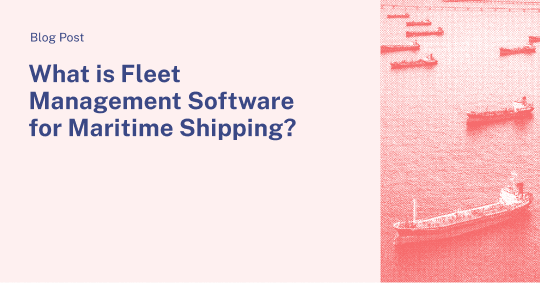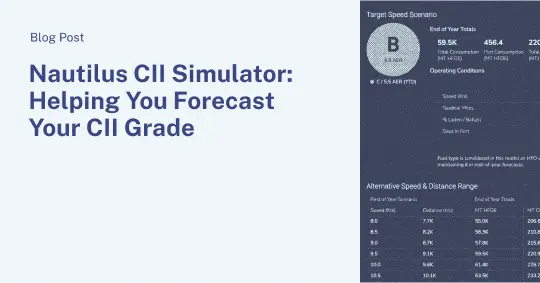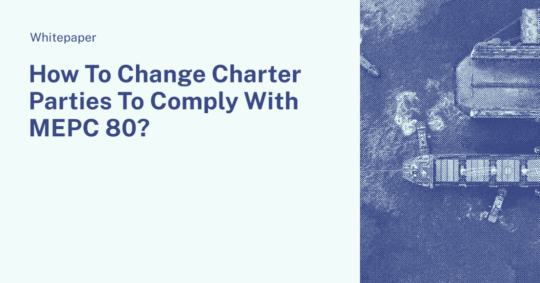Last week, I went to Houston to speak at the S&P World Petrochemical Conference next week. A big topic was the profitable decarbonization of the industry in line with resilience and digitalization. Looking at solutions for emissions reductions that are already available, especially vessel and voyage optimization are quite prominent. By optimizing vessel performance, we can reduce fuel consumption and, in turn, reduce carbon emissions. The same goes for optimizing voyages. With state-of-the-art models and real vessel performance profiles, we can take into account weather conditions, vessel safety concerns, regulations, cargo conditions, desired ETAs, and other constraints to reduce fuel consumption and CO2 emissions. While these optimizations are essential, they only allow us to solve part of the fuel consumption and greenhouse gas emission problem.
So what needs to happen to achieve the remaining ~90% on our path to net zero?
The biggest portion is locked up behind inefficiencies in the system as a whole, not in any single vessel or voyage. To achieve meaningful progress in reducing carbon emissions in the maritime shipping industry, we need to really enable stakeholder alignment and collaboration.
The inefficiencies in the system stem from the interactions and constraints introduced by the counterparties that participate in the chartering of a vessel, their differing economic incentives, and existing legacy ways of allocating the unplanned costs and risks of a voyage. The result is a framework that disincentivizes collaboration and leaves stakeholders to operate in silos.
Take performance claims as an example. Performance claims occur when the performance of a chartered vessel does not meet the warranted performance as specified in the charter party agreement between the owner of the vessel and the charterer. The current practice of measuring vessel performance is static, with the warranted fuel consumption at one or more speeds based on measurements of the vessel’s performance at some point in time. However, a vessel’s performance changes over time, and this creates an issue when both parties have to settle the question of actual performance by going into arbitration.
Another example of shipping’s structural inefficiencies is the entrenched “hurry up to wait” behavior. In a voyage charter, certain timeframes are fixed in the charter party agreement. When a vessel arrives at the port, a clock starts ticking on the time a charterer has to unload the cargo. If that time is exceeded, the owner can charge demurrage in compensation for the additional time for which the vessel can’t be chartered out again. The owner is required to proceed with the “utmost despatch” to get the vessel to its destination on behalf of the charterer. However, the combination of utmost despatch and the realities of port operations, not to mention the opportunity to make money on demurrage, create a situation where slower steaming to hit a just-in-time ETA isn’t incentivized.
Legislation and regulation have the potential to encourage change in our industry, but they may not necessarily promote collaboration between owners and charterers
The International Maritime Organization’s (IMO) Carbon Intensity Indicator (CII) regulation puts the responsibility for vessel performance as it relates to CO2 emissions squarely on the shoulders of Owners. But Owners are in a tricky position with respect to CII—they are dependent on the Charterer for many of the decisions that will ultimately impact their CII score. There’s an understanding that somehow the impact of CII should be felt by both Owners and Charterers, but it’s not clear how to distribute that impact. BIMCO, one of the world’s largest shipping associations, drafted and adopted a CII clause in an attempt to establish some collaboration between Owners and Charterers on this front, to some criticism!
EU ETS for shipping will go into effect in 2024. For now, its effects may be more apparent than CII’s because it requires operators to purchase and/or trade emissions allowances with a monetary cost, while CII currently only requires low-scoring vessels to develop and receive approval for a corrective action plan. My colleague, Taylor March, recently wrote a blog post on “Three ways the EU ETS is going to rock the boat” – vessel selection, shipbuilding and purchase, and carbon trading.
Static vessel descriptions don’t enable efficiency
To find the path toward a solution it helps to think about how and where digitalization can play a role in facilitating collaboration, and what new technologies will be required in that system. I talked about the static descriptions of speed and consumption in charter party agreements, and mentioned how the behaviors that result (e.g. claims) work against the collaboration necessary to operate a ship at its most efficient. What if there were a better way?
What if a vessel description could be dynamic? What if Charterers could make voyage plans taking into account the actual performance of the vessel? And what if Owners could accept lower fees for underperformance (and perhaps higher fees for overperformance), or could work with their Charterer to schedule proactive maintenance when the vessel is berthed, thus ensuring peak performance? In any case, by having access to an independent description of vessel performance, and a charter party agreement with clauses that permit and encourage the right behaviors, both parties would be more easily incentivized to ensure good performance, avoid claims, reduce fuel and reduce CO2.
Virtual arrival embraces stakeholder collaboration and vice versa
Another area where collaboration between parties can reduce fuel costs and CO2 emissions is arrival at port. What if there were a means for the parties in a voyage to agree on a time of arrival at port based on the availability of and a commitment by the port to a berth? More significantly, if that arrival time had to be revised, perhaps due to congestion at the port, what if stakeholders could agree to a “virtual arrival” time? The industry would see profitable emissions reductions without concerns for demurrage, having to wait in line for berth availability, and without the fear of penalty for failing to operate with the utmost despatch. To solve these systemic issues, we need cooperation between ports, charterers, and vessel owners, underpinned by a willingness to work collaboratively and share insights for equitable outcomes.
At Nautilus, we believe that leveraging data from vessels is essential to reducing carbon emissions in the maritime shipping industry. If our ecosystem can enable stakeholders to collaborate and align their incentives, we can unlock this data, drive fleet efficiency, and reduce carbon emissions.
—
In case you missed it: Matt Heider, CEO, recently spoke at the Financial Times Commodities Global Summit 2023. Read the event recap here or submit the form below to access the full library of exclusive Financial Times Summit content and interviews, including Matt’s speeches at the event.


